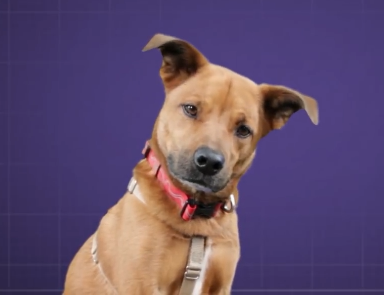You've probably seen a dog tilt its head in response to a weird noise or something you said. It's super cute, but why do they do it?
你一定见过狗狗对奇怪的噪音或你的话做出歪头的反应吧。超级可爱的说,但是它们为什么要歪头呢?
The answer's not entirely clear, and there hasn't been any peer-reviewed research about it.
我们还不是很清楚其中奥秘,也不曾有对其做过研究。
But a couple of scientists hypothesize that head-tilting might help dogs see and hear us better.
不过,有几位科学家假设,歪头可能会帮助狗狗们更好的观察、倾听我们。
One popular idea comes from a 2013 blog post by a psychologist named Stanley Coren,
2013年,一位名叫Stanley Coren的心理学家在博客上发表了一篇大家普遍认可的观点,
who studies dogs and their behaviors, among other things.
这位心理学家主要研究狗狗及它们的行为等。
He thinks that puzzled tilt means a dog is trying to see you better.
他认为让人摸不着头脑的歪头,代表着狗狗想更好的看清你。
When you speak to someone, dog or otherwise, you express a lot of emotion with the lower half of your face.
当你和某人或狗狗等说话时,你的大部分表情会通过脸的下半部分来表达。
And according to a small 2015 study, it seems like our canine companions can tell the difference between facial expressions that show emotion, like happiness or anger.
根据2015年的一项小研究,似乎我们的犬类同伴能够分辨表达情绪的面部表情,如开心或生气。
But a dog with a bigger muzzle might not be able to see your smile or frown clearly,
但是鼻口部较大的狗可能看不清你的微笑或皱眉,
so Coren suggests that tilting helps them get a better view.
所以,Coren认为歪头能够帮助它们仔细观察。
He tested this idea by surveying 582 dog owners online, asking them to describe their dog's breed or head shape,
通过对582名狗主人做在线调查,Coren对这个观点进行了检测。Coren要求狗主人描述他们狗狗的种类或头型,
and then rate how frequently their dogs do the head-tilting thing.
并估计狗狗们歪头的频率。

The data were split into two groups. One was brachycephalic dogs with flatter faces like pugs;
数据被分为两组。一组是扁平脸的短头狗,如八哥犬;
and the other was a mix of mesaticephalic dogs with medium muzzles like beagles and dolichocephalic dogs with long noses like greyhounds.
另一组是中等鼻口的中型头狗狗,如猎犬和长鼻子长头狗狗,如灰狗的混合组。
In Coren's survey, 71% of owners of bigger-muzzled dogs reported that their pups "frequently", "most of the time" or "always" tilt their heads when spoken to,
在Coren的调查中,71%的大鼻口狗狗的主人称,在和他们的狗狗说话时,它们“经常”、“大部分时间”、“总是”歪头,
as opposed to only 52% of owners of smaller-muzzled dogs.
而仅有52%的小鼻口狗主人反映过这种情况。
That, he says, is a statistically significant difference, but 52% is still a lot of dogs, so this probably isn't the whole story.
Coren表示,从数据上来看,差别非常明显,但是52%仍是相当大的比例。因此,该观点并不能代表整个事情的原委。
A psychologist who runs a dog cognition lab named Alexandra Horowitz thinks that dogs could be trying to hear us better with those sideways looks.
一位经营一家狗狗认知实验室的心理学家,Alexandra Horowitz认为狗狗侧眼看能使它们更好地倾听我们。
Specifically, she thinks they're tilting their heads to adjust the floppy parts of their ears, called pinnae, to get a better sense of where sounds are coming from.
她认为狗狗们歪头是为了调整耳部的耷拉部分--耳廓,以便更好地分辨声音的来源。
A third take from a dog trainer named Steven Lindsay, is that dogs tilt their heads because one part of their brain is involved in both listening and body language.
第三种观点来自一位训狗师,Steven Lindsay。她认为狗狗歪头是因为它们大脑的一部分负责了听力和肢体语言两个区。
We think a region called the nucleus ambiguus controls a dog's head movements, as well as the muscles in a dog's middle ear that help it perceive subtly different sounds.
我们认为疑核区域控制着狗狗的头部动作以及中耳的肌肉,能帮助它们精确地察觉不同的声音。
So Lindsay suggests that when your pup is listening, it can't help but show you with its body, too.
因此,Lindsay认为,当你的狗狗在倾听时,它们会情不自禁的向你展示它们的肢体语言。
We don't really know how accurate any of these guesses are, but we do know that dogs tilting their heads is real cute.
我们并不清楚这些猜测是否准确,但是我们都认同狗狗歪头的动作太可爱啦。
So to any animal psychologists out there: round up some puppies, do some research, and post more of these adorable videos online... for science!
所以建议我们的心理学家:养一些狗狗,做一些研究,然后上传更多可爱的视频...当然,为了科学嘛!
Thanks for asking, and thanks especially to all of our patrons on Patreon who keep these answers coming.
谢谢大家的提问,特别感谢Patreon上一直提问的观众。
If you'd like to submit questions to be answered, or get some videos a few days early, go to patreon.com/scishow.
欢迎登陆patreon.com/scishow向我们提问并观看我们的视频。
And don't forget to go to youtube.com/scishow and subscribe!
另外,不要忘记去youtube.com/scishow订阅我们的栏目哟!


